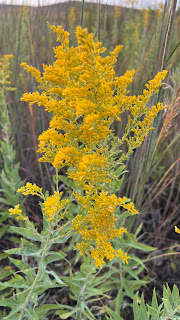These August and September days in Kansas are what ProfessorRoush has always referred to as the "doldrums." The hot, dreary, drought-ey days of the year when, most years, the garden dries up before it has a chance to really display the colors of fall and not much is blooming or growing. Days when I badly neglect the garden and frankly don't care if it rains because I'm tired of the weekly care and mowing. The only time the garden and I see each other right now are every few days when I carry water to a few young roses just to keep them alive until dormancy. Everything else can wait as the heat dies away and a little rain returns. Tonight and tomorrow, we have the first chances predicted for rain in weeks, so I'm hopeful and prayerful that its thirst gets quenched. It probably won't matter to the prairie grass right now, which has recognized the changing season and is drying and storing nutrients for next year.
Gardeners always seem to ask "what's blooming now?" of each other, and I'll confess that the only truly bright spot in my garden right now is this superb (in my opinion) combination of dwarf crape myrtle 'Cherry Dazzle®' and the 'Heavenly Blue' morning glory that I let self-seed everywhere. At least, I think it's still 'Heavenly Blue" because it has seeded itself and in-bred so many years that it might just be the wild variety by now. If you were to see my landscape around the house now, I'd only ask you to please don't criticize me for the rampant vines everywhere, but to wait until morning to pass judgement. They look like heck at midday but they're a sight for sleepy eyes to behold in the morning!
The 'Cherry Dazzle®', also known as Gamad 1 (U.S. Plant Patent #16,917) is another matter entirely. Most of the spring and summer I spend worrying that it has survived or isn't doing well, and then here in late August it is the shining red star of the garden. Right outside my bedroom window, it catches my eye alongside the sunrise every morning, and I'm happy that it has its own spotlight moment. 'Cherry Dazzle®', if you're looking for a low-growing crape, grows consistently 2-2.5 feet tall here in Kansas each year, although described as
3-5 feet height at maturity elsewhere. Introduced and named by
Professor Michael Dirr in 2006, it seems to be healthy and cold-hardy here, returning reliably from its roots each spring, and its leaves in most climates are reported to be burgundy-red in the fall. Here, I recall they unfortunately seem to go straight from green to brown and fall off. Incidentally, check out that link to Dr. Dirr, a University of Georgia horticulturist who has the distinction of his own Wikipedia page!
.jpg)
The busy bumblebee pictured above and at the left has no time for the dazzle of 'Cherry Dazzle®', intent only on darting in and out of the 'Heavenly Blue' blossoms for their nectar. Taking these photos, I had to wait as it dived in each flower head first, brazenly showing only its backside until it bumbled backward and flew to the next. I wonder, as I often do, what the bee sees? The actual vivid colors of both, the shapes of the flowers, the contrast between the two, or something else, with its advanced bee senses, that I can't even fathom? One way or another, arriving just as I began to photograph the plant, he/she didn't care about the gardener who was clicking the oblong black thing furiously at them as they went from one blossom to the next. For me, the combination of both plants is incredibly soul-satisfying and I'm not sure if I really prefer the "heavenly" shade of blue or the dazzling cherry-red, but it's clear what the bee prefers. One thing I am sure of is that I need to remember that the morning glory is not only important to me, but to the ecological health of my garden.

.jpg) So consider this a short tour of the ditches alongside the road. Of course, this time of year, Goldenrod is everywhere. My plant identification is suspect as always, especially here given the number of native Goldenrods, but I believe the photos above and left are of Tall Goldenrod, Solidago altissima, although it could be Canadian Goldenrod, the former being a subspecies of the latter.
So consider this a short tour of the ditches alongside the road. Of course, this time of year, Goldenrod is everywhere. My plant identification is suspect as always, especially here given the number of native Goldenrods, but I believe the photos above and left are of Tall Goldenrod, Solidago altissima, although it could be Canadian Goldenrod, the former being a subspecies of the latter..jpg) There is a lot of White Sage, Artemsia ludoviciana. on the walk, everywhere in the adjacent prairie, its hairy-gray leaves befitting a plant adapted to drought and grazing.
There is a lot of White Sage, Artemsia ludoviciana. on the walk, everywhere in the adjacent prairie, its hairy-gray leaves befitting a plant adapted to drought and grazing..jpg) Nearly last, but certainly not least, clumps of the the most "garden-worthy" of the prairie plants, Dotted Gayfeather, Liatris punctata, "dots" the prairie with low light purple spires. Butterflies love this plant, and often are above it in a swarm.
Nearly last, but certainly not least, clumps of the the most "garden-worthy" of the prairie plants, Dotted Gayfeather, Liatris punctata, "dots" the prairie with low light purple spires. Butterflies love this plant, and often are above it in a swarm. .jpg)
.jpg)
.jpg)
.jpg)
.jpg)
.jpg)
.jpg)
.jpg)
.jpg)
.jpg)
.jpg)
.jpg)
.jpg)
.jpg)